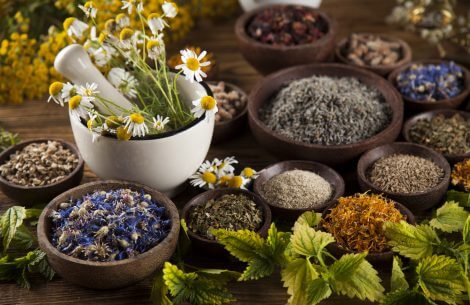The use of herbs for treating and preventing illnesses is the oldest form of medicine. Every culture across the world has a history that includes ancient ancestors using herbs for health. Experimentation by trial and error is how they learned the health benefits of plants.
Today, medical practitioners have science behind them when they prescribe herbs to their patients. They rely on the science that separated components from plants to identify, classify, and study them. As a result, modern herbal medical practitioners have a vast reference system to rely on. One of these scientific discoveries was “herbal action:” the medicinal action and classification of these actions with regard to the effect herbs have on the body’s physiological processes.
Herbs have chemical plant compounds, and the compounds can have specific medical benefits to heal diseases or improve health. They perform in a certain way in the body. For example, antimicrobials resist or kill pathogenic microorganisms. Garlic and thyme are classified as antimicrobials.
Also, an herb can have several actions. For example, garlic has five other actions, and thyme has four. The synergy of these actions in a single herb or with other herbs is an important aspect of prescribing medicinal herbs. By some account, there are over 200 herbal actions.
While the list of herbal actions is too extensive to list, here are a few of the more common ones along with a few examples of their herbs.
Adaptogens – They help the body to cope and handle stress. Adaptogens have a significant impact on the adrenals (Astragalus, Siberian Ginseng, Ashwagandha).
Analgesics (Anodynes) – The herbal action of analgesics is to relieve pain both internally and externally (Cayenne, Willow Bark, Hops).
Anteimintics – Anteimintics expel or eliminate parasites in the digestive system. (Garlic, Wormwood, Black Walnut).
Anticatarrhal – These herbs reduce excess mucous and phlegm caused colds, allergies, and other conditions (Elderberry, Ma Huang, Eye Bright).
Antimicrobial – The actions of these are antibacterial and antiviral. They inhibit the growth of bacteria and viruses (Licorice, Echinacea, Osha).
Antiemetic – Herbs in this classification reduce nausea and relieve vomiting (Lemon Balm, Ginger, Chamomile).
Anti-inflammatory – Herbs that help to control inflammation due to disease, injury, etc. (Garlic, Willow, Licorice).
Antioxidant – Herbal actions that inhibit oxidation that produce free radicals which are responsible for many illnesses, such as cancer (Ginkgo Biloba, Schisandra, Turmeric).
Antiseptic – Herbs that fight infections by prohibiting bacterial growth (Thyme, Tea Tree Oil, Calendula).
Antispasmodic – These herbs reduce cramps and muscle spasms (Peppermint, Passionflower, Ginger).
Astringent – The herbal action that contracts or tightens tissue. You may have noticed the sensations after drinking a cup of black tea or a glass of wine (Witch Hazel, Uva Ursi, Shepherds Purse).
Bitter – Bitter herbs stimulate the digestive system and are a tonic for it. Many in the healthcare field think most people don’t eat enough bitter foods, such as kale and watercress (Dandelion, Osha, Gentian).
Carminatives – Herbs that ease pains from and expel gas. They are usually taken after meals (Fennel, Ginger, Anise).
Emollients – These herbs soothe and soften skin. Emollients can also aid wound healing (Aloe, Marshmallow, Comfrey).
Expectorant – These herbs expel excess mucus from the body. They are helpful during cold and flu season (Fenugreek, Licorice, Horsetail).
Febrifuge – Herbs that help control or reduce fever (Peppermint, Elder Flower, Calendula).
Laxative – The herbal action of laxatives stimulate the digestive system to encourage bowel movement (Dandelion, Juniper, Oregon Grape).
Nervines – The mechanism of herbs have a beneficial benefit on the nervous system. Herbs in this class affect the nervous system in different ways. They address issues, such as anxiety, depression, insomnia, and others (Gotu Kola, St. John’s Wort, Ma Huang, Kava Kava).
Tonics – These herbs strengthen or regenerate specific organs or systems as a whole. They are like a “pick-me-up” for the body (Eyebright, Kelp, Bilberry, Wild Yam).
There’s much more than herbal action that goes into using herbs as medicine. They can also have adverse effects on the body. So, it’s essential to seek the advice and guidance of a health professional that is qualified in herbal medicine. Some of these types of healthcare providers are Naturopathic doctors, Traditional Chinese Medicine practitioners, certified Herbalist, and Ayurvedic doctors. Also, some Chiropractic doctors have training in herbal medicine.
Thousands of years and science separate them, but ancient and modern herbalists have one thing in common: They understand that herbs have a language. And understanding the language of herbs is knowing how they act in a human body.
This information is for educational purposes only. It’s not to diagnose or treat illnesses or diseases. Always seek the advice of your doctor before using herbs for health conditions.
References:
- Macrides, Dipaunka. Herbal Actions Defined. Retrieved from http://www.theherbalist.com.au/herbal-actions-defined.
- Marciano, Marisa, Dr. Vizniak, Nikita, Dr., Botanical Medicine. Herbs, nutrition, hormones, and medications. 2018, Professional Health Systems, Inc.
- Vaughn, Kris. Understanding Herbal Action. Retrieved from https://herbs.motherearthliving.com/understanding-herbal-actions/.

